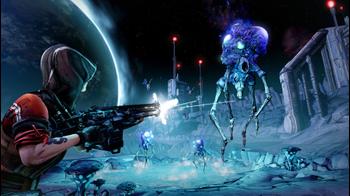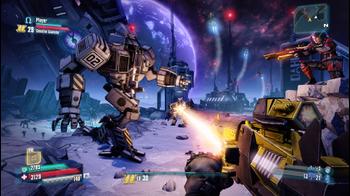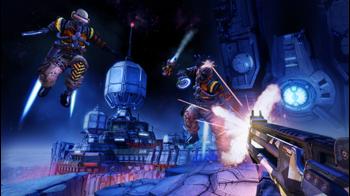
Borderlands: The Pre-Sequel Hands-On
When you say the key premise of Borderlands: The Pre-Sequel out loud, it sounds like the most simple and obvious concept for a sequel ever. Stuck for an idea? Let's take it to the moon.
You can imagine that being scrawled on a meeting room whiteboard somewhere or at the top of a proposal document, and it's no surprise to my mind that the folks at 2K dropped a great big tick next to it and said "Okay, we're on board." To the moon it is.
Discounting the recently-released and middling-quality PS Vita port of Borderlands 2, The Pre-Sequel, which we nicknamed Borderlands 1.5 on our E3 appointment schedule, is the first proper Borderlands release not developed by series creators Gearbox. This could be a worry. The team behind it, 2K Australia, has a pretty damn solid list of hits on its resume, notably including all three Bioshock releases - but they only ever helped on those games - they never led. With Gearbox there for a helping hand but not for the bulk of development, that's a risk - but, after some time with the game, it's a risk that appears to be paying off.
Make no mistake, this is still Borderlands. In many senses it feels more like an expansion pack to Borderlands 2 than a fully-fledged new game, the like of which we'll probably see from Gearbox, and for the newly-released platforms, further down the line.
Here you'll see repeated assets, a repeated engine, and a very similar artistic style - just in a new setting and with some new twists. It's plain from the moment I pick p the controller that this game is, additions or no, only for those who really enjoyed - and are willing to accept more - of Borderlands 2's specific brand of madness.
Primary amongst the new additions is of course that crazy lunar setting and the new gameplay mechanics it brings with it. Players can now double-jump as a result of the reduced gravity with two taps of the jump button, and the jumps you manage travel far further and are far more floaty - and useful - than in the other Borderlands titles.
The swimmy movement in the air thanks to the reduced gravity makes it easier to get about the battlefield, for one, but it also means you can fight and move at the same time. In the brief demo we played, it made more sense to keep on the move and blast enemies from the air than it did to take cover and pick your shots. In that, one simple mechanical change completely changes the flow of almost all of the game's combat.
The new moon-jumps have one more advantage in a gameplay sense - they facilitate the addition of a ground-pound move. Crouching in the air sends you hurtling to the ground at speed, doing damage to those unlucky enough to be beneath it. It's satisfying.
Another major adjustment that changes how you think about combat comes in the form of oxygen. Each character has an oxygen meter that gradually depletes when out in the open on the moon. This appears to be something that can be extended or reduced with careful choices of equipment from your loot, but another way to increase your potential space to move is to power up stations that create bubbles of oxygen across the moon's surface.
Verbal warnings shout out to you as oxygen runs low, serving as a warning to dash back to the nearest oxygen bubble or power up a new one. It changes the way you fight, especially when mission objectives are stored a little way away from where the nearest oxygen bubble is - again, it's something new to consider when plotting how to approach a combat scenario.
The oxygen mechanic was overwhelming and worrying at first, and something that I felt could potentially ruin the carefree blasting that has made Borderlands so popular. After a few minutes, however, I'd become accustomed to it and was dashing in and out of oxygen bubbles with ease.
With that said, it's still a mechanic that'll have to walk a fine line between being a clever thing to consider and an annoyance in the final release - and I look forward to seeing how that pans out in the final release.
For those more interested in the loot aspect of the series, there's a few new things there, too, including some new types of equipment and most notably two new types of weapons. The first, lasers, set enemies ablaze and streak across the environment satisfyingly, but didn't feel that different to the regular guns to me. Better were the ice-based weapons, which can freeze an enemy solid for you to shatter with a melee attack, ground pound, or simply a hail of bullets. Those felt good. Each weapon manufacturer has its own set of ice and laser mechanics, adding to even more variety. New enemies to blast are mingled with some semi-familiar Borderlands fodder - adjusted to be lunar-friendly, of course.
While the four playable characters still slot into the same basic class archetypes as the cast of the first two releases in the series, each comes with three unique ability trees which lead to different builds with different move sets and styles. I got to try out two of the classes, and both felt to do justice to what has come before - there's still plenty of RPG in this shooter, even if each entry seems to be getting subsequently more manic.
The build we toyed with had some technical issues such as a slightly skittish frame rate and some muddy textures, but we hope these will be ironed out for launch. It's pushing the Borderlands 2 engine and the last-generation consoles a little bit further still, but hopefully there's a balance struck with performance to ensure things run smoothly come the game's October release.
As always with Borderlands, thirty minutes or so at a trade show is never quite enough to really get an idea of what the final game will be like. Much depends on the quest structure, the way the different character builds shake out as you level up, and that oh-so-addictive loot system.
The elephant in the room remains that this is still essentially something like an expansion to Borderlands 2 - and without a doubt isn't really a fully-fledged upgrade to the Borderlands universe. It's a stepping stone to keep people interested, it's clear, until Gearbox does something truly new with the franchise - though based on this brief demo, there's still a decent chunk of new stuff to toy with if you enjoyed Borderlands 2. How these new concepts hold up in a full release remains to be seen.
Based on what we've experienced thus far, if you're looking for more Borderlands in your life and don't mind playing it on last-gen machines - so far, so good. We'll check in with Borderlands: The Pre-Sequel again closer to its launch.
Borderlands: The Pre-Sequel is set to launch on the 14th October in North America and the 17th October elsewhere for PC, Xbox 360 and PlayStation 3. It is available for pre-order now.


